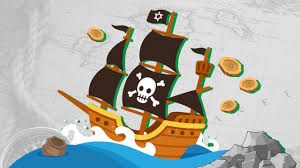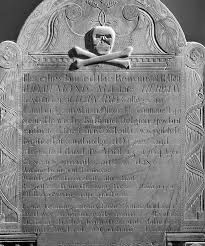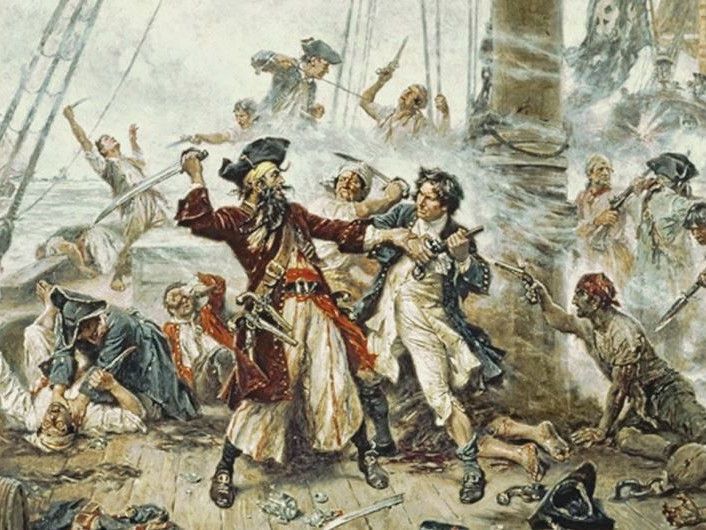On 19 September enthusiasts for the phenomenon of pirate culture will be addressing each other with cries of “Aaargh”, “Shiver me timbers”, “Keelhaul the Landlubber” and “Giz Grog” thus celebrating nearly a century of silver screen dramas. These culminated in the Pirates of the Caribbean series which are reported as having brought to Walt Disney and Jerry Bruckheimer productions a billion dollars in box-office takings.
Piracy reached its zenith in the 16th and 17th centuries when it was centred on the Gulf of Mexico the border territories of which were known as The Spanish Main. Treasures consisting mainly of gold, silver and exotic merchandise were collected by the conquistadores from points as far afield as Manila and the Andes and bought across the isthmus of Central America from Acapulco by mule train to the port of Vera Cruz. The heavily-laden merchant vessels were then formed into convoys before being escorted by large galleons across the Atlantic Ocean to Spain. Despite the highly superior armaments of the Spanish fleet, the swifter small boats of the pirates enabled sea manoeuvres which could cut out stray vessels. These were then boarded and taken to any one of the numerous islands of the Caribbean of which perhaps Jamaica was the most favoured as a location for the first criminal world trade centre!
The wealth of Spain was regarded as fair game for the navies of England, Holland and France whether or not war had been declared. In times of pseudo peace, it became the custom for warrants to be issued by governments to privately owned warships which then sailed the high seas looking for prey whose cargoes could be sold and shared. These became known as privateers whose free-for-all actions were often indistinguishable from those of independent pirates.
Due to the expulsions of 1497 and the severity of the later religious enforcements of the Catholic Inquisitions (instituted in Portugal in 1536), it is unsurprising to find that many sea-brigands were of Sephardic ascendancy and thus hell-bent with motives of both revenge and greed.

Perhaps the most famous of these was Moses Cohen Henriques (MCH) who was born in Portugal in 1595 and baptised as António Vaez Henriques being the first son of a New Christian family which shortly thereafter emigrated to Amsterdam. There they reverted to Judaism and attended a synagogue led by Rabbi Samuel Palache (see 2. below). Being of an adventurous nature, MCH joined the Dutch West India Company and rose to become next in rank to Admiral Piet Hein who was fiercely anti-Spanish having served for four years as a slave prisoner on one of their mighty galleons.
In year 1628 Piet and MCH intercepted one half of the Spanish treasure fleet off the coast of Cuba which soon capitulated to the faster Dutch sloops. In triumph, the ensemble voyaged to Amsterdam where it took five days to unload the booty which was valued at 11.5 million guilders – equivalent today to nearly USD one billion. This was then shared among the crews and the worthy burghers to bring an important stimulation to the economy.
Inspired by success, MCH then acted as an undercover agent in the Portuguese colony of Pernambuco on the coast of Brazil and, in year 1630, led a Jewish contingent force of 3,000 men in conquest. Following this, synagogues were built so that it became a refuge for Sephardim under Dutch rule which lasted until year 1654 when the Portuguese recaptured their territory.
Although many of the Sephardim fled northwards to New (York) Amsterdam, some of his former shipmates were led by MCH to join the pirate fleet of Henry Morgan.They were so successful with their part in raids that they were able to station their own flotilla at an island off the Brazilian coast. From there, they wreaked vengeful havoc in the Spanish and Portuguese shipping lanes. However, even buccaneers must retire so, in 1681, MCH founded a peaceful Jewish community in Jamaica and was given a full pardon by the English governor of the newly conquered island – his erstwhile partner in crime, the politically crafty Henry Morgan !

Here are more names from the annals.
1. Sinan Reis. His Sephardic family fled from religious persecution by the Inquisition to Smyrna (presently Izmir in Turkey). Like MCH he sought revenge on the Catholic church by joining the Ottoman navy and rose through the ranks to become vice-admiral to the famed Hayreddin Barbarossa. In year 1538 it is reported that “The Great Jew” had prepared a fleet of warships and a force of marines to do battle with that of the Holy Roman Empire at Preveza in the Gulf of Arta. Following this triumph, he sailed as a Barbary corsair and commanded forces which secured many victories along the coast and in the Indian ocean. He died in 1546.
2. Samuel Pallache. He was born in year 1550 to a rabbinical family which had moved to Morocco at the time of the 13th century Reconquista. His career began as a merchant adventurer which involved frequent visits to Holland where he became a diplomat as being the agent of the Sultan. As such he signed a commercial treaty of co-operation between the two countries which involved joint military resistance to Spanish interests. This included the granting to him of a warrant to carry out privateering activities in the coastal waters of Iberia following which booty was sold through his commercial network. As a pious rabbi, he ensured that 10% of loot was given to charity and kept to kosher rules when at sea. He was instrumental in founding the Amsterdam Sephardic community and held the first minyan of sixteen worshippers at his home in 1596 after which the Neve Shalom synagogue was opened with his cousin, Isaac Uriel, who officiated at his death in February,1616.
3. David Abrabanel is recorded as being a 17th century buccaneer who was descended from an “an Old World Rabbinic Dynasty that claimed descent from King David”. He commenced by working with English privateers but soon captained his own vessel named “Jerusalem”. For unknown reasons he adopted the nom de guerre of “Captain Davis” and worked his pirate crew along the Pacific coast in a series of raids on Spanish shipping and ports. He maintained a base on what has been thought to be Easter Island but this and the circumstances of his death remain a mystery.
4. Yaacov Kuriel was born to a family which had been pressured by the Inquisition to become New Christians. He joined the Spanish navy under the name of Diego da Garcia and rose to the rank of captain before being arrested by the Inquisition. However, his crew of mainly converso sailors mutinied to release him and together they became pirates. Using a flotilla of three warships based at Port Royal in Jamaica, they spent years raiding Spanish and Portuguese shipping. Little is known about his later life but, as a pious Jew, he is thought to have returned to Israel to study the Kabbalah.
5. Jean Lafitte was one of the last Jewish pirates but was also one of the most dreaded. He died in 1823 at the age of 43. He is first recorded. In 1805, as owning a warehouse in New Orleans from which he distributed various merchandise which had been smuggled by his bother Pierre but, following the Embargo Act of 1807, they moved to an island off the coast of Louisiana. So successful was their business that they extended it to piracy but this was brought an abrupt conclusion in 1812 by the confiscation by US government forces. However, assistance given by the brothers to Andrew Jackson in the war against the British brought both praise and a pardon after which they enlarged their fleet and opened a new colony named Campeche on Galveston Island. From there the trading in smuggled or stolen goods became even more profitable. Lafitte died in 1823 as a very rich man.
In this short summary, I have omitted any reference to the participation by all of these criminals in the slave trade as this is to be the subject of a separate essay now in preparation. Readers may care to reference my previous work “Sephardic Identity” as published in The Portugal News, 27 October 2023
by Roberto Cavaleiro - Tomar. 15 September, 2025













